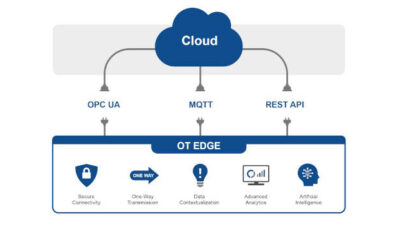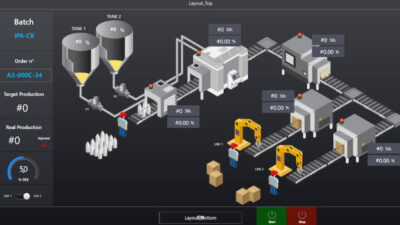Manufacturing Insights has dubbed SAP, HP, Oracle, Microsoft, and IBM "the most influential vendors in the manufacturing industry." The analyst firm also has agreed to let MBT print excerpts from its extensive report on these vendors' approach to the manufacturing space. This first article in a five-part series focuses on SAP.
Those of you that are familiar with our research themes will recognize the SHOMI (pronounced ‘show me’) acronym which is shorthand for the most influential technology vendors in the manufacturing industry– SAP, HP, Oracle, Microsoft, and IBM. As we progress through a difficult 2008, these vendors continue to extend their reach and provide a wide breath of products, deep sub-vertical expertise, and the ear of executive management.
We thought this would be a good opportunity to see how these vendors are positioned and to provide some guidance to the buying community about how to take advantage of the different strategies.
In more general IT terms, the vendors are providing products to optimize operations through technologies like virtualization, Web service-based integration, collaborative decision making, and business network automation.This is the first of five part series covering each of the vendors. SAP .
SAP– Answers in the Applications
SAP remains the market share leader for ERP in the manufacturing market with particularly strong numbers in the enterprise class (revenue > $1B).
SAP may also have the most fidelity to its roots in enterprise applications.ssful co-development projects with Microsoft, and both IBM and HP rely on SAP for sell through of services and hardware.
However, SAP’s application leadership position is also under attack.have to reconcile its desire to grow its Neoware product line with the revenue potential from services related to the SAP platform.
Architecture– Power in the PlatformSAP deserves credit for patiently pursuing its vision of creating an integrated process platform, extended via a service oriented architecture, and allowing independent software vendors into the ecosystem to fill the white space of specific process domain or industry requirements.
However, the sheer size of the platform and upgrade, whether technical, functional, or transformative, can be intimidating.at SAP, but in the long run Manufacturing Insights expects the customer base to implement upgrades and take full advantage of NetWeaver.
Lining SAP up to our reference model reveals good support for virtualization technology at the physical level with many companies undertaking both data center and ERP instance consolidation efforts.At the industry process platform level, SAP sets the standard.lting ability to create composite applications is what defines a true platform.
SAP is also getting a better handle on its message for collaborative decision environments.monstration of its workspace environment that provides a mechanism for users to create a corrective action process on the fly that allows for both highly structured processes and ad hoc collaboration. Manufacturing Insights believes that this capability could prove to be extremely valuable to SAPcustomers.
At the multi-enterprise network level, SAP certainly understands that the market is moving toward enabling entire business networks, but hasn’t fully come to grips with what SAP can do to support the trend.
Manufacturing Insights suggests that they should look at their Business by Design architecture.a foreign joint venture, etc.). Using this capability –call it Venture by Design – the enterprise company could bring strategic partners together on a common system to operate these specific purpose networks over their useful life.
Supply Chain– Extending the ReachSAP has continued to broaden their supply chain offering through organic development.SAP clearly understand the challenges that face their current and prospective clients, and as we move into 2008, appear well positioned to offer applications to address many of these supply chain challenges:
••••
There has been clear focus on demand and supply planning (APO), along with the recognition that demand sensing technologies are an important part of the future supply chain.ints and alternative solutions.
SAP has remained committed to their SCE suite (Transportation, Warehouse and Event Management) even as the world has focused on planning and demand-driven applications.n managing the globally extended supply chains that characterize many industries and companies.
In the context of extended supply chains, the emergence of supply network collaboration tools is a welcome addition, particularly for businesses who are finding it difficult to effectively manage their networks. The ability to treat myriad suppliers, contract manufacturers, and third-party logisticians as an extension of your organization, while managing to a pre-defined set of KPIs has the potential to significantly enhance the performance of these networks.
Product Lifecycle– Seeking Product TruthSAP, like most other SHOMI vendors, does not have the deep roots in mechanical CAD that mainstream PLM vendors (Siemens PLM, Dassault, PTC, AutoDesk) have.
SAPs view ofersion of the product truth”. SAP is able to manage and synchronize multiple views via Master Data Management (MDM): not only design and manufacturing, but also market, customer, financial, logistics, and supplier information.
SAP’s MDM and, consequently, its PLM strategy leverages NetWeaver to connect and synchronize multiple data sources and process platform.oduct management.
Manufacturing Insights has two concerns here.longer just “lookup part number X in inventory.”, it assumes a high level of semantic definition inside the processes and in the processes interfaces. Is SAP going to drive the effort to define the ontology and semantics of deep services? Is SAP going to become the de-facto custodian of theseservices and services directories on behalf of an industry?
Emerging Agenda– Driven by Practical Business NeedsSAP’s approach to RFID is somewhat conservative but very much in line with SAP’s overall strategy in that it is very practically driven by business requirements and not by a specific type of technology because it happens to be in vogue.d to remain in the platform manager seat if and when customers want to incorporate RFID technology.
SAP’s response to growing interest in using IT for Green initiatives or sustainability also has a very practical approach, in that it is woven into the company’s existing Governance, Risk, and Compliance Solutions.n, and product management is combined with business intelligence. We expect 2008 to be an interesting year for this area of functionality for SAP.
Advice for Users– Upgrade to Lower Costs/Diversify ChoicesSAP enterprise class customers are very satisfied that core financial, order management, and resource planning functionality performs to expectations.has built custom extensions. Many have used instance consolidation projects as the basis for getting on the latest version.
Instance consolidation is a very worthwhile effort given the need for manufacturing firms to become globally integrated.environments. A service repository that makes composition and integration more straightforward should also facilitate the implementation of best-of-breed applications, whether they are NetWeaver certified or not, and help you to take some control of your application portfolio in order to increaseyour negotiating leverage with SAP.
What are your thoughts? [email protected] .



